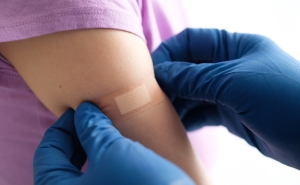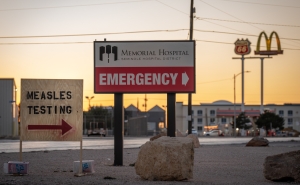Why Don't We Have an HIV Vaccine?
Science is still trying to catch up to the world’s most cunning virus.

In the four decades since the HIV epidemic exploded, more than 40 million people have died from the virus.
HIV continues to be a major threat to public health, with over 38.4 million people living with HIV worldwide in 2021. Research funding is there to address the epidemic—so why don’t we have a vaccine?
We’re still trying to outsmart the virus, says vaccine expert Anna Durbin, MD. Its elusive, ever-changing nature leaves popular methods of vaccine development falling flat. And a growing faction of people who are at risk for acquiring HIV believe that, thanks to the use of preventive treatment like PrEP and post-infection antiretroviral therapy, HIV isn’t a serious risk—much less the death sentence it once was.
But Durbin, a professor in International Health, isn’t discouraged. She says that while there will be no HIV vaccine by 2030—the year set for ending the AIDS epidemic in the UN Sustainable Development Goals—PrEP and new monoclonal antibody therapies may provide a bridge until a vaccine is developed. Here, Durbin discusses the obstacles to developing an HIV vaccine and envisions how it might roll out when we have one.
A Shape-Shifting Virus
Most vaccines induce our body to make antibodies to fight different pathogens, but HIV disguises itself, so that even if we do make antibodies, the virus changes to escape them.
Early vaccine candidates targeted what we call the envelope protein that encapsulates the virus genome. When we found that antibodies against the envelope protein didn't work, then we thought, maybe we can target different parts of the virus that induce T cells, which kill infected cells. But because the virus integrates itself into the host genome, the T cells didn't recognize the viruses as separate from hosts.
Limitations of Current Technology
Because the virus itself integrates into host DNA, it limits the vaccine platforms we can use. We traditionally have used live attenuated vaccines for different viral diseases like measles, mumps, and rubella, but we can't use that for HIV because of the concern that live attenuated virus could integrate into the [host cells’] DNA and elicit disease. There are also many different subgroups, or clades, of HIV. If you make a vaccine against clade A, it may not work against clade B or clade C.
One of the problems with mRNA vaccine technology [used for the COVID-19 vaccines] is that there's a limit to how much mRNA you can have in a vaccine. For COVID, the vaccine included mRNA for making one viral protein, the spike protein. We don't know how many proteins we can express with this mRNA technology in a single vaccine, and that may be limiting for HIV vaccines.
The Vaccine Trial Landscape
There have been more than 250 HIV vaccine trials, most of them early-stage, looking at whether the vaccine is safe and whether we mount an immune response following vaccination. There have been very few vaccine trials—10 or so—that have advanced to the point of looking at efficacy. Of those, one showed 31% efficacy at 42 months. That was the most promising trial, but the efficacy fell off very quickly, and it was only 31% and only against clade B. Whether that would translate to the other clades is not clear.
Unfortunately, we're not going to have a vaccine by 2030, but there's a lot of funding still around HIV vaccine research. The excitement has dimmed a bit because of the failures, but there's still a lot of research into trying to develop a safe and effective HIV vaccine. I think if we had a vaccine that showed great promise in efficacy trials, there would be a ton of funding around it.
The Promise of Monoclonal Antibody Treatment
The Vaccine Research Center (VRC) at NIH has come up with a passive immunization strategy—monoclonal antibodies. Passive immunity happens when a person is given antibodies to a disease rather than producing them through their own immune system.
Scientists at the VRC found that some people who had been infected with HIV for a very long time had highly potent, broadly neutralizing antibodies that recognize a lot of different HIV strains and clades. They have isolated those broadly neutralizing antibodies, sequenced them, made them synthetically, and given them in experimental trials to see if they can prevent infection. That has been very promising. The problem is that you have to keep giving people the monoclonal antibody [to maintain immunity]. Even if you have one that is very durable, that lasts, for instance, six months, that still means you have to give that [antibody] every six months or so.
Right now, they're trying to focus on making a vaccine that will induce the body to produce these highly neutralizing, broadly active antibodies. We just haven't found the right sequence to put into the vaccine.
Changing Perceptions of Risk
I was in medical school at the beginning of the HIV epidemic, and I'm still working in a clinic that treats people living with HIV. I think a lot of people have forgotten the number of people who died from HIV. There's not the fear of HIV that there was in the 1980s, because now we have treatment. Now people perceive the disease, to some extent, as a chronic illness like diabetes or high blood pressure, where you take medication, and everything's fine.
It's great that we have these treatments, but I think people just don't appreciate how horrible the disease is. Hopefully when an HIV vaccine is available, they will get vaccinated. But there is the perception that, oh, I can just take a pill and everything's fine.
The Prevention Puzzle
One of the reasons there's so much funding for PrEP is that we don't have a vaccine. PrEP one of the only ways that we can help prevent HIV infection.
We're still waiting for large efficacy results to come out on monoclonal antibodies, which is a form of PrEP. If those are shown to be highly efficacious, then at least in high income countries, you're going to see that as the [prevention] strategy. They're trying to make them longer-acting, so you would only need an injection every three months or six months. I think that's where some of the funding is going to go, but I don't see that as a solution for low- or middle-income countries, because they'll be too expensive.
Envisioning an HIV Vaccine Rollout
As with all vaccines, we’d have a trial, a scale up, and a rollout. Before we have enough vaccine for everyone, it would be targeted to those at highest risk. As more vaccine becomes available, I would see it being incorporated into routine immunization, much like hepatitis B vaccines.
Children certainly won't be the first to receive these vaccines. They will be far down the line for a couple of reasons. We'll be looking for continued safety, we'll be looking for durability of efficacy, because that's going to partially drive when the first vaccination should occur. For instance, if the durability of efficacy is five years, vaccinating at birth doesn't really make sense.
As we first roll it out, I think the recommendation would be maybe 15 and older. The priority would be to get them vaccinated before becoming sexually active to maximize the benefit. I think young adults would be willing to be vaccinated. I think if you said, "you can prevent getting HIV by getting vaccinated," most people who perceive themselves at risk would get vaccinated.
There likely would not be an upper age limit early on because you could be infected with HIV at any age.
HIV Prevention for All
If there were an effective HIV vaccine, I think it would be taken up by most countries, with few exceptions. The goal would be getting such a vaccine to a point where low- and middle-income countries can afford it, and providing them access is going to be the biggest hurdle.
What I hope will be a benefit of the COVID pandemic, particularly in low- and middle-income countries, is greater capacity to manufacture vaccines. That would certainly reduce the cost of HIV vaccines for low- and middle-income countries. The Serum Institute of India is a great example. They make 75% of the doses of vaccines that are given globally. And if we had more manufacturers like that in Africa, in parts of Asia, in South America, that would increase the capacity to make vaccines and would lower the cost of vaccines for low- and middle-income countries. To do that, that technology would have to be transferred. Hopefully that will happen.
Morgan Coulson is an editorial specialist at the Johns Hopkins Bloomberg School of Public Health.





